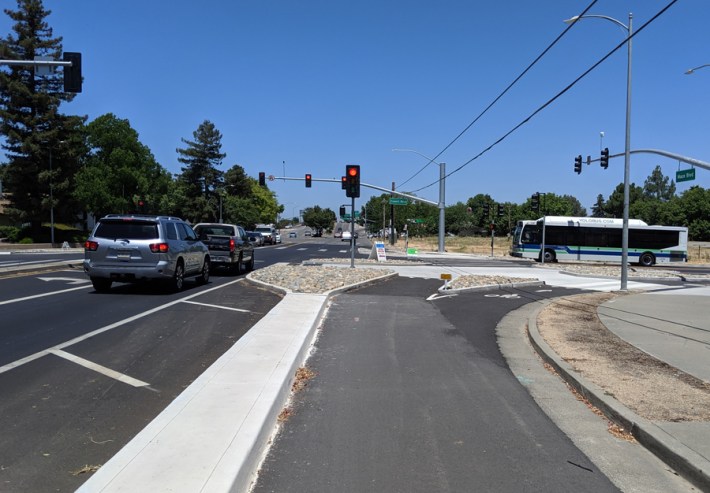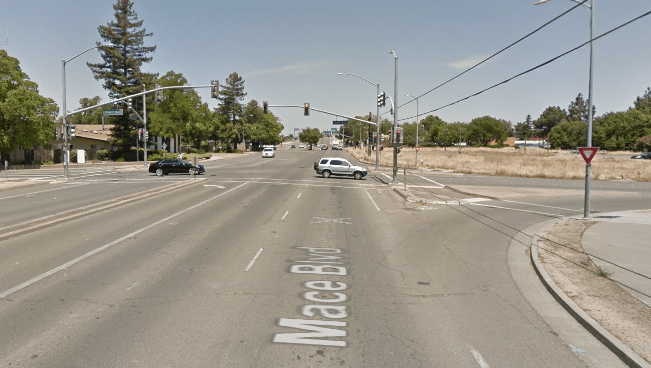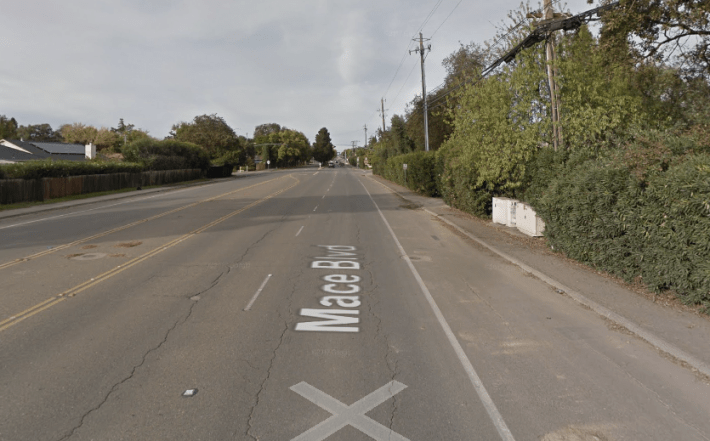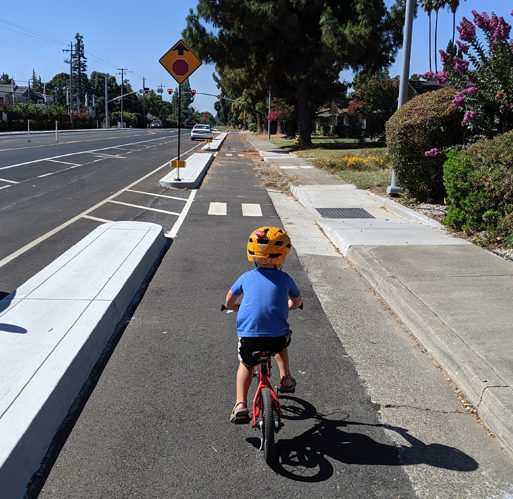Note: GJEL Accident Attorneys regularly sponsors coverage on Streetsblog San Francisco and Streetsblog California. Unless noted in the story, GJEL Accident Attorneys is not consulted for the content or editorial direction of the sponsored content.
It seemed straightforward enough.
Wide, underused Mace Boulevard in Davis needed repaving. Its faint bike lane markings didn't make the street feel safe for riding, especially to parents of students at the local elementary school, Pioneer. Over eighty percent of those students were driven to school, the highest percentage for any school in Davis.
So the city changed it. Mace was repaved and vehicle lanes were reduced from two to one in each direction. A curb-protected cycle track replaced the faded bike lane. Right-turn slip lanes that encouraged fast, wide turns at the corner with Cowell were eliminated, replaced with a version of a protected intersection that featured wider crosswalks and pedestrian refuge islands.

Planning took several years, beginning with a grant application to SACOG in 2013. Construction finally began at the beginning of the school year in 2018. That kept the road torn up for a long time, and by the time the project was finished last spring, patience had worn thin. The local NextDoor site was filling up with complaints, and the city held several workshops to update residents about the project.
The new configuration was completed before school let out for the summer, but just barely. Nevertheless, a count taken on Bike to School Day in May showed significant increases in students biking to school. Local parents like Drew Hart felt safer letting their children bike along the new lanes, now protected by a substantial curb from fast vehicle traffic on Mace.
But even Davis, whose reputation as the "bike capital" of California has faded like the former Mace Blvd bike lanes, is not immune to driver backlash.
Drivers complained about losing a lane; they complained about having to slow down to make a right turn; they complained that it was difficult to get in and out of traffic congestion on Mace. Mostly they complained about heavy traffic. They showed up angry at public meetings and shouted down opponents.
Hart, whose children go to Pioneer, went to one of the meetings to support the project, which he said has made the area much safer for his kids. City staff, he said, "were being yelled at." He spoke out, saying, "My biggest concern is that all of these comments will cause the project to get ripped out. It's been poorly managed, but it has merit." In response, he said, "I got booed."
This kind of backlash is nothing new for planners and designers and advocates of safer infrastructure, especially road diets; in fact it's come to be expected that people get upset and complain about changes to the streetscape. Usually the right thing to do is let some time pass, so people get used to the new design, and to allow time to collect data on safety and any mode shifts that might occur.
But in this case the city is already planning to tear out some of the just-installed concrete, and is considering other changes that could eliminate the road diet, potentially reducing the bike-lane barriers and/or shifting the new bikeway. The plan is to remove the new concrete islands at the intersection at Cowell as soon as possible, preferably before school starts again in the coming weeks.

In other words, the finished project won't exist long enough to properly test whether it meets its primary goal, which, according to its grant application, is "to increase bicycling and walking to Pioneer." The application specifies that:
A 2013 Safe Routes to School audit determined that a perceived lack of safety when traveling on or crossing Mace Blvd is a major barrier to parents allowing their children to walk or bike to school. Furthermore, a June, 2013, Open House for this project revealed neighborhood residents would walk or bike on Mace Blvd if speed concerns were addressed and bicycling safety and comfort were improved.
Meanwhile, the city has hired a team of consultants to weigh in on potential ways to change the new design to get vehicle traffic back to its original free-flow condition. According to Mayor Brett Lee, the hope is that they can begin reconstruction as soon as this fall.
He acknowledges that the timing is not great.
The problem is that the complaints about traffic congestion, while not utterly without merit, are scapegoating the long-planned bike safety project. When it was being conceived and planned, traffic on Mace Blvd. was light. No official traffic study was done, but existing traffic counts showed less traffic on Mace than on Fifth Street, where Davis had already built a successful road diet.
But between planning, design, and construction, circumstances changed. Traffic on nearby I-80, which cuts through Davis on its way between Sacramento and the Bay Area, had been growing steadily. This is especially the case on Thursday and Friday afternoons, when residents from the Bay Area and points south head to the mountains on weekend trips. In response, Caltrans had changed the meter timing at the Mace Blvd. on-ramp, slowing down the rate of vehicles entering the highway there.
And then came Waze.
Mace Blvd. is almost the last entry point onto nearby I-80 for drivers heading to Sacramento. East of Davis, the causeway on the Yolo Bypass is the only way across the wide Sacramento River flood zone for miles to the north and south. The causeway is a chokepoint, with traffic frequently backing up before it in both directions--which is a bit mysterious because it isn't narrower than the rest of I-80, just raised up on a long bridge structure. Whatever the cause, the traffic backups can extend deep into Davis.
Waze gives drivers who wouldn't normally know a way around that congestion alternatives via frontage roads and parallel county roads. The number of drivers getting off I-80 as far west as Dixon has been rising since the advent of Waze. County roads absorb them readily, but they all have to get back on the freeway before hitting the causeway--which means at Mace Blvd. Even if a driver wants to continue east to the very last possible on-ramp, right where the causeway begins, they first have to traverse Mace.
So local residents are complaining about traffic congestion that begins and ends far beyond their neighborhoods. Drivers are up in arms about the road diet because they can't use what used to be excess lanes to get around that traffic, and the congestion is making everyone tense.
On busy afternoons, according to Mayor Lee, "traffic tops out at three times the normal counts; the new design cannot handle that traffic."
"On Friday afternoons, to go the equivalent of two San Francisco city blocks in distance takes twelve minutes," he told Streetsblog. "It literally is gridlock. People are mostly stopped, and they inch forward."
Lee says he wants to meet the original safety goals of the Mace Blvd. project, but not at the expense of other users. "A sizable group of folks believe that to make things better for cycling, we need to make it worse for cars," he said, but he doesn't see it that way. Lee has spent a lot of time thinking about bike-friendly designs, and even took a group of city staff and a city councilmember to Holland to learn about Dutch road design.
"In Holland, there isn't that kind of zero-sum thinking. In some places, maybe it's necessary; but it's not generally true," he said. On Mace, "we were trying to design something better for bikes and pedestrians--and for cars. We want it to be equivalent to what it was for cars. I believe it can be done because there is a lot of width on Mace. There's room for a decent sidewalk, for a decent protected bike lane, and for traffic lanes."
Lee believes the new configuration on Mace is "clumsy, even from a bicyclist's perspective." He describes the curbs protecting the bikeway as excessive. "It's literally as if somebody in Stalinist Russia declared that there will be bike lanes," he said. "They're there all right, you can't miss them."

But even if the new configuration were completely ripped out and Mace went back to its previous stroad design--which is not something the city wants to do--that congestion wouldn't go away. Lee and the city council are considering some ideas to help with that, but it's not clear whether they will be able to put them into play.
For example, they want to convince Caltrans to speed up the metering lights at Mace, so cars can proceed more quickly onto the freeway. But Caltrans slowed down those lights because the congestion on I-80 can't handle the increased traffic.
They also speak of changing signal patterns on Mace south of town, to hold traffic on the county road and discourage drivers from choosing that route, or make it look less attractive on Waze. But that could cause other issues; traffic planners are concerned that an arbitrary red light might be ignored by drivers who can't see the point of waiting when they can see no cross traffic. It also might not have much effect on Waze algorithms; a small backup on a county road would probably still look like a better bet than a major jam on the freeway.
It's not an easy fix. There's not a whole lot the city can do about traffic outside its boundaries, as made clear by a note from Davis police chief Darren Pytel, who led one of the recent contentious meetings about the project.
Pointing out that the city cannot restrict passage on its streets to city residents, he writes:
In interpreting the Vehicle Code, California courts have consistently recognized the State’s policy that the streets of a city belong to the people of the state, and the use thereof is an inalienable right of every citizen and that all persons have an equal right to use them for purposes of travel.
Which is, of course, the point of making those streets available, and useful, for local residents who want their kids to be able to bike and walk on them safely.
It's disheartening that a project aimed at increasing biking and walking, and thus reducing at least some local driving, could fall victim to pressures to accommodate even longer highway trips that occur only at certain times.






